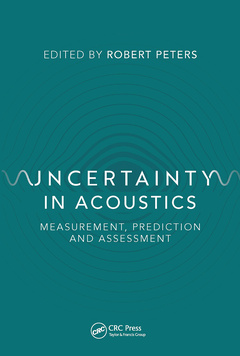Uncertainty in Acoustics Measurement, Prediction and Assessment
Coordonnateur : Peters Robert

This guide to estimating uncertainties in the measurement, prediction and assessment of noise and vibration applies across environmental noise and vibration, occupational noise and vibration exposure, and building and architectural acoustics.
The book collates information from the various Standards and from research, with explanation, examples and case studies. It enables estimation of uncertainty in the measurement and prediction of acoustic quantities, suitable for use in environmental impact and occupational exposure assessments. It is for acoustic consultants, mechanical and building service engineers, architect and building professionals and environmental health officers.
Bob Peters worked for more than forty years in acoustics and noise control ? teaching, research, consultancy. He was a principal acoustic consultant with Applied Acoustic Design, a senior research fellow at London South Bank University, and a tutor on Institute of Acoustics distance learning courses.
1. Introduction and Concepts
2. Uncertainty in Acoustic Measurements
3. Measurement Uncertainty Associated with Sound and Vibration Instrumentation
4. Uncertainty in the Prediction of Sound Levels
5. Uncertainty in Environmental Noise Measurement
6. Uncertainty in Room Acoustics Measurements
7. Speech Transmission Index (STI): Measurement and Prediction Uncertainty
8. Uncertainty Associated with the Measurement of Sound Insulation in the Field
9. Uncertaintly in Measuring and Estimating Workplace Noise Exposure
10. Uncertainty in the Measurement of Noise Emission from Plant and Machinery
11. Uncertainty in the Measurement of Vibration Levels
12. Uncertantly in Prediction of Rail-induced Ground-Borne Vibration
13. Managing Uncertainty in Noise Assessment Processes
14. Uncertainty in International Acoustics Standards
Dr. Bob Peters passed away early on 22nd June 2019. Bob was well known for his unbridled enthusiasm for and contributions to acoustics education. I had the pleasure and privilege of working with him for many years through both the Open University and the Institute of Acoustics (IOA).
Bob studied Physics at Imperial College, London, graduated in 1965 and stayed on to study for a PhD in Physics which included taking the Chelsea College MSc in Acoustics and Vibration Physics, taught by Professor R W B Stephens. Bob remained at Imperial as a research assistant in underwater acoustics until 1969 and obtained his PhD, supervised by Professor Stephens, in 1971.
After three years researching diesel engine noise for CAV Ltd and two years teaching at Twickenham College of Technology, Bob moved to North East Surrey College of Technology (NESCOT) where he remained for 23 years. He started and ran Diploma and MSc programmes at NESCOT until 2010. Few acousticians will be unaware of Bob’s text ‘Acoustics and Noise Control’ (3rd edition is published by Routledge). This was the basis for much of Bob’s rewrite of the General Principles of Acoustics Module for the IOA Diploma in 2008. While at NESCOT, Bob was a guest lecturer in acoustics on undergraduate and postgraduate courses at many other institutions, including the University of North London, Oxford Brookes University, Imperial College and UCL. For around 25 years, until 2017, he delivered a significant part of the MSc in Environmental and Architectural Acoustics at London South Bank University. He also acted as an examiner for several PhD students around the country.
After retiring from NESCOT, he embarked on a new career in consultancy, while continuing with a range of teaching activities. For 22 years he worked part time as Principal Consultant with Applied Acoustic Design (AAD) where his main responsibilities included computer modelling of indoor spaces and expert witness duties.
In addition to h
Date de parution : 04-2022
15.6x23.4 cm
Date de parution : 07-2020
15.6x23.4 cm
Thèmes d’Uncertainty in Acoustics :
Mots-clés :
Coupling Loss Factor; sound transmission; Rail Pad Stiffness; sound measurement; UK Control; accuracy; Sound Pressure Levels; environmental noise measurement; Standard Uncertainty; noise prediction; Sound Level Meter; occupational exposure assessment; BS En ISO; uncertainty; Sound Power Level; occupational noise; IEC Guide; building service engineers; Road Traffic Noise; architectural acoustics; Noise Exposure; environmental noise; BS En; Expanded Measurement Uncertainty; Vibration Levels; Octave Band; Uncertainty Budget; Equivalent Continuous A-weighted Sound Pressure; National Metrology Institute; Measurement Uncertainty; Floating Slab Track; STI; Calibration Cavity; Weekly Personal Noise Exposure; Noise Emission Levels



